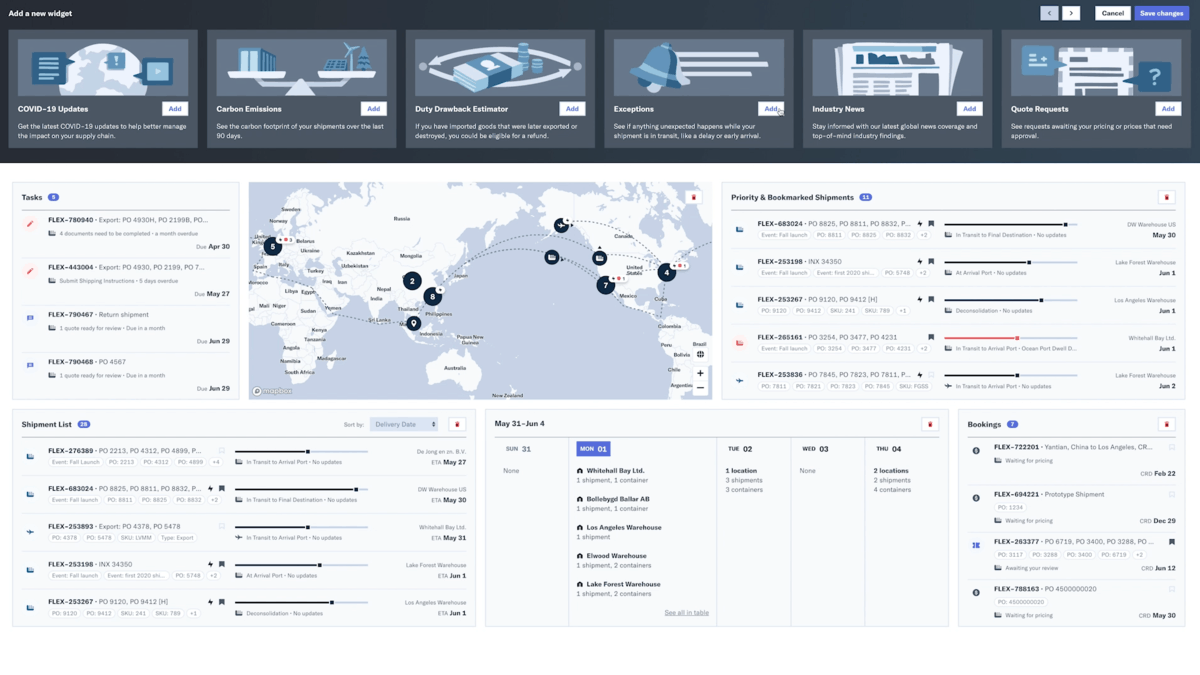Flexport, the San Francisco-based digital freight forwarder, rolled out an array of platform upgrades to its global customer base of about 10,000 shippers Thursday.
The changes to the Flexport’s platform create more flexibility in the user experience. Large importers, small importers and exporters now have preconfigured dashboards available — more on that later — that are customizable by drag and drop and Flexport’s platform has been completely optimized for mobile devices.
“Why I think this is especially impactful is that we’re bringing a consumer-grade experience to the customer platform, which is not very common to the B2B software space or logistics industry,” said Frank te Pas, senior product manager at Flexport. “These drag-and-drop experiences are normally what you’d expect in a consumer app, it’s very easy to get going on and clients don’t really need onboarding to start personalizing. That was confirmed in our pilot. Within two weeks, more than 70% of the users had engaged with the feature and saved their configuration in the dashboard.”
Flexport’s new features seem intended to drive stickiness in certain use cases and enable a broader swath of operators to work naturally in its user environments.
Two related trends made the new upgrades possible. First, Flexport’s customer base is diversifying. Broadly speaking, the company is onboarding larger customers that have more Flexport users per logo, which means more discrete job functions are using the platform for specialized purposes. But Flexport also has thought hard about how exporters, as opposed to importers, think about their daily tasks differently. For example, exporters tend to think in terms of cargo ready dates rather than cargo delivery dates, and that is reflected in the new preconfigured dashboards offered to exporter customers.
Secondly, as monthly active users on the Flexport platform grow (and during the COVID-19 pandemic, te Pas said MAUs have grown 21% so far), Flexport learns more about how its customers work and how they use the platform. That information in turn powers a rapid feedback loop enabling Flexport’s engineering team to ship new software dozens of times a day.
The new functionality, including preconfigured experiences based on customer type, drag-and-drop customization and optimization for mobile, were tested in a pilot of 42 clients in Europe, North America and Asia with hundreds of users.

“The vision is one unified platform bridging together different entities in global trade, and as Flexport grows to include more diverse entities, the question is how can you make sure you’re delivering an experience that works for all them,” te Pas said.
Small importers, large importers and exporters don’t necessarily think about their supply chains in the same way. Flexport noticed that small importers, for instance, like to see all of their shipments in one place, whereas large importers that have many more shipments and lanes tend to manage by exception and perhaps want to see only flagged or critical shipments and alerts when something requires their attention.
Meanwhile, exporters’ typical tasks focus on the preparation of documents and shipments for pickup and making sure that everything is ready to go on time, which is why cargo ready dates are the critical scheduling device. In Flexport’s network, which has the greatest density in the trans-Pacific trade, exporters often work in Mandarin and other East Asian languages, so Flexport has enabled easy implementation of experiences in those languages.
“Once clients are served with the new dashboard, they can further tailor that experience based on their unique workflow needs,” te Pas said. “They can go into their dashboard to reorder and reconfigure modules with dragging and dropping, add widgets and make the experience their own.”
One new widget available to Flexport clients is a specialized carbon tracker that analyzes clients’ shipments’ CO2 emissions, helps them make scheduling and modal choices based on environmental impact and lets them track progress in Flexport’s Carbon Offset program.
Another new feature offers fresh COVID-19 updates on industries, geographies and infrastructure such as specific container terminals. The pandemic’s impact has evolved to affect shipper verticals and modes of transportation differently, and Flexport’s widget allows decision-makers to refer to the latest information in the same platform that houses their freight.
The mobile optimization of the Flexport platform is part of a broader effort that will eventually create personalized experiences based on job type. Flexport found that, for example, warehouse operators who are uploading documents and taking photos of container seals with mobile devices spend lots of time on their feet. Other job functions, like logistics directors with a strong analytics focus, constantly check data on their phones as they move from meeting to meeting. The new mobile experience dynamically sizes itself to fit mobile or tablet screens and, for example, adjusts the number of days automatically displayed on schedules depending on screen size.
Eventually, te Pas said, Flexport will create completely personalized experiences for workers based on job type, whether they’re involved in warehouse operations, compliance, finance or providing transportation.











